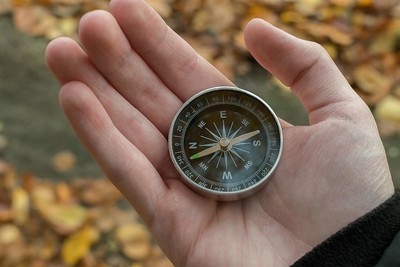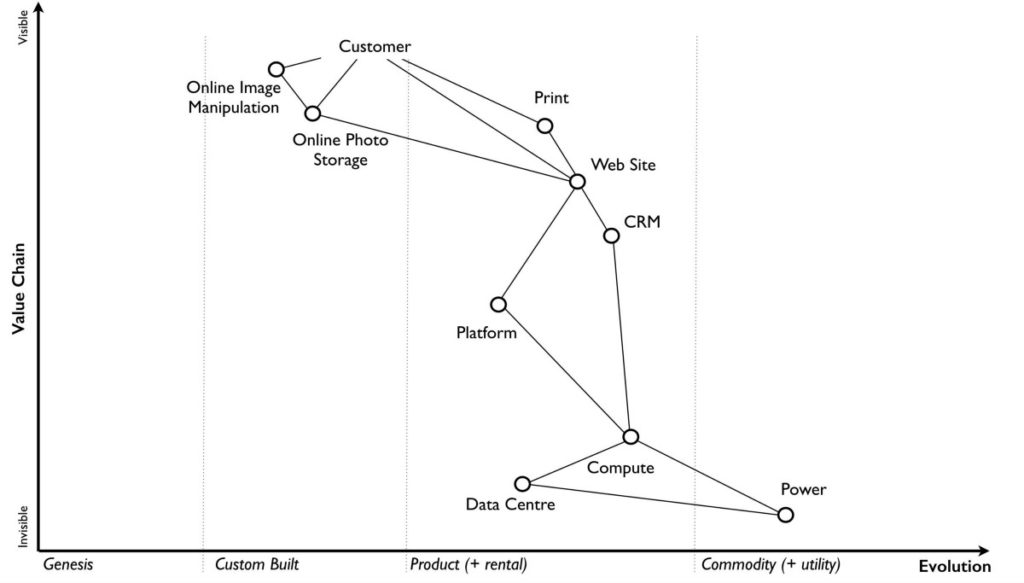Archive for the ‘Maps’ Category
If you want to make progress, make a map.
 Fascination with the idealized future state isn’t ideal. Before moving forward, define the current state of things.
Fascination with the idealized future state isn’t ideal. Before moving forward, define the current state of things.
Improvement opportunities mean nothing unless they come from a deep understanding of the state of things as they are. Define things as they are before settling on improvement opportunities.
If you want to converge on a common understanding of how things are, make a map.
In times of uncertainty, there’s no way to know the destination. Assess your location, look for low-energy paths, and investigate several in parallel.
If you want to understand the situation as it stands, try to make a map. The gaps in the map define your learning objectives. And once the map hangs together, show it to someone you trust and refine it.
Before there can be agreement on potential solutions, there must be agreement on the situation as it is. Take time to make a map of the situation and show it to those who will decide on potential solutions. Create potential solutions only after everyone agrees on the situation as it stands.
If there’s disagreement on the map of the current state, break the regions of disagreement into finer detail until there is agreement.
It may seem slow and wasteful to make maps and create a common understanding of how things are. But if you want to know slow and wasteful, look at how long things take when that work isn’t done.
If you want to make progress, make a map.
Image credit — maximilianschiffer
Instead of rebranding, why not keep the brand and improve your offering?
 Cigarette companies rebranded themselves because their products caused cancer and they wanted to separate themselves from how their customers experienced their products. Their name and logo (which stand for their brand) were mapped to bad things (cancer) so they changed their name and logo. The bad things still happened, but the company was one step removed. There was always the option to stop causing cancer and to leave the name and logo as-is, but that would have required a real change, difficult change, a fundamental change. Instead of stopping the harm, cigarette companies ran away from their heritage and rebranded.
Cigarette companies rebranded themselves because their products caused cancer and they wanted to separate themselves from how their customers experienced their products. Their name and logo (which stand for their brand) were mapped to bad things (cancer) so they changed their name and logo. The bad things still happened, but the company was one step removed. There was always the option to stop causing cancer and to leave the name and logo as-is, but that would have required a real change, difficult change, a fundamental change. Instead of stopping the harm, cigarette companies ran away from their heritage and rebranded.
Facebook rebranded itself because its offering caused cancer of a different sort. And they, too, wanted to separate themselves from how their customers experienced their offering. The world mapped the Facebook brand to bullying, harming children, and misinformation that destroyed institutions. Sure, Facebook had the option to keep the name and logo and stop doing harm, but they chose to keep the harm and change the name and logo. Like the cigarette companies, they chose to keep the unskillful behavior and change their brand to try to sidestep their damaging ways. Yes, they could have changed their behavior and kept their logo, but they chose to change their logo and double down on their unhealthy heritage.
The cigarette companies and Facebook didn’t rebrand themselves to move toward something better, they rebranded to run away from the very thing they created, the very experience they delivered to their customers. In that way, they tried to distance themselves from their offering because their offering was harmful. And in that way, rebranding is most often about moving away from the experience that customers experience. And in that way, rebranding is hardly ever about moving toward something better.
One exception I can think of is a special type of rebranding that is a distillation of the brand, where the brand name gets shorter. Several made-up examples: Nike Shoes to Nike; MacDonalds Hamburgers to MacDonalds; and Netflix Streaming Services to Netflix. In all three cases, the offering hasn’t changed and customers still recognize the brand. Everyone still knows it’s all about cool footwear, a repeatable fast-food experience, and top-notch entertainment content. If anything, the connection with the heritage is concentrated and strengthened and the appeal is broader. If your rebranding makes the name longer or the message more nuanced, you get some credit for confusing your customers, but you don’t qualify for this special exception.
If you want to move toward something better, it’s likely better to keep the name and logo and change the offering to something better. Your brand has history and your customers have mapped the goodness you provide to your name and logo. Why not use that to your advantage? Why not build on what you’ve built and morph it slowly into something better? Why not keep the brand and improve the offering? Why not remap your good brand to an improved offering so that your brand improves slowly over time? Isn’t it more effective to use your brand recognition as the mechanism to attract attention to your improved offering?
In almost all cases, rebranding is a sign that something’s wrong. It’s expensive, it consumes a huge amount of company resources, and there’s little to no direct benefit to customers. When you feel the urge to rebrand, I strongly urge you to keep the brand and improve your offering. That way your customers will benefit and your brand will improve.
Image credit Quinn Dombrowski
Situational Awareness (Winter is Coming)
 Business and life are all about choosing how you want to allocate your time and money. In life, it’s your personal time and money and in business it’s the company’s.
Business and life are all about choosing how you want to allocate your time and money. In life, it’s your personal time and money and in business it’s the company’s.
If you’ve ever done any winter hiking, you know that it’s important to know the terrain. If there’s a mountain in the way, you either go over it or around it. But there is one thing you can’t do is pretend it’s not there. If you go around it, you’ve got to make sure you have enough energy, food, water and daylight to make the long trek to shelter. If you go over it, you’ve got to make sure you have the ice picks, crampons, down jackets and climbing skills to make it up and down to shelter. With winter hiking, the territory, gear and team capability matter. And the right decision is defined by situational awareness.
And what of the shelter? Does it sleep five, six or seven? And because you have seven on your team, it’s not really shelter if it sleeps five. And if you don’t know how many it sleeps, you’re not situationally aware. And if you’re not situationally aware, on five may fit in the shelter and two will freeze to death. Maybe before your trip you should look at the map and learn all the shelters their locations and how many the can hold. The right action and the safety of your crew depends on your situational awareness.
And the decision depends on how much daylight do you have left. Before you left basecamp it was possible to know when the sun will set. Did you take the time to look at the charts? Did you take advantage of the knowledge? If you don’t have enough sunlight, you’ve got to go over the top. If you do, you can take the leisurely great circle route around the mountain. And if you don’t know, you’ve got to roll the dice. I’d prefer to be aware of the situation and keep the dice in my pocket. And for that, you need to be aware of the situation.
Winter hiking is difficult enough even when you have maps of the terrain, weather forecasts, locations of the shelters and knowledge of when the sun will set. But it’s an unsafe activity when there are no maps of the territory, the weather is unknown and there’s no knowledge of the shelters. But that’s just how it is with innovation – the territory has never been hiked, no maps, no weather forecast, and shelters are unknown. With innovation, there’s no situational awareness unless you create it. And that’s why with innovation, the first step is to create the maps. No maps, no possibility of situational awareness.
The best people at situational awareness are the military. The know maps and they know how to use them. The know to do recon to position the enemy on the map and they know to use the situational awareness (the map, the enemy’s location, and their direction of travel) to decide how what to do. If the enemy’s force is small and in poorly defensible position, there are a certain set of actions that are viable. If the enemy force is large and has the high ground, it’s time to sit tight or retreat with dignity. (To be clear, I’m a pacifist and this military example does mean I condone violence of any kind. It’s just that the military is super good at situational awareness.)
If you’re not making maps of the competitive landscape, you’re doing it wrong. If you’re not moving resources around and speculating how the competition will respond based on the topography and your position within it, you’re not sharpening your situational awareness and you’re not taking full advantage of the information around you. If you don’t know where the mountains are you can’t avoid them or use them to slow your competition. And if you don’t know know where the shelters are an how many miles you can hike in a day, you don’t know if you’re overextending your position and putting your crew at risk.
Winter is coming. If you’re not creating maps to build situational awareness, what are you doing?
Image credit – Martin Fisch
Choosing What To Do
 In business you’ve got to do two things: choose what to do and choose how to do it well. I’m not sure which is more important, but I am sure there’s far more written on how to do things well and far less clarity around how to choose what to do.
In business you’ve got to do two things: choose what to do and choose how to do it well. I’m not sure which is more important, but I am sure there’s far more written on how to do things well and far less clarity around how to choose what to do.
Choosing what to do starts with understanding what’s being done now. For technology, it’s defining the state-of-the-art. For the business model, it’s how the leading companies are interacting with customers and which functions they are outsourcing and which they are doing themselves. In neither case does what’s being done define your new recipe, but in both cases it’s the first step to figuring how you’ll differentiate over the competition.
Every observation of the state-of-the-art technologies and latest business models is a snapshot in time. You know what’s happening at this instant, but you don’t know what things will look like in two years when you launch. And that’s not good enough. You’ve got to know the improvement trajectories; you’ve got to know if those trajectories will still hold true when you’ll launch your offering; and, if they’re out of gas, you’ve got to figure out the new improvement areas and their trajectories.
You’ve got to differentiate over the in-the-future competition who will constantly improve over the next two years, not the in-the-moment competition you see today.
For technology, first look at the competitions’ websites. For their latest product or service, figure out what they’re proud of, what they brag about, what line of goodness it offers. For example, is it faster, smaller, lighter, more powerful or less expensive? Then, look at the product it replaced and what it offered. If the old was faster than the one it replaced and the newest one was faster still, their next one will try to be faster. But if the old one was faster than the one it replaced and the newest one is proud of something else, it’s likely they’ll try to give the next one more of that same something else.
And the rate of improvement gives another clue. If the improvement is decreasing over time (old product to new product), it’s likely the next one will improve on a new line of goodness. If it’s still accelerating, expect more of what they did last time. Use the slope to estimate the magnitude of improvement two years from now. That’s what you’ve got to be better than.
And with business models, make a Wardley Map. On the map, place the elements of the business ecosystem (I hate that word) and connect the elements that interact with each other. And now the tricky part. Move to the right the mature elements (e.g., electrical power grid), move to the middle the immature elements (things that are clunky and you have to make yourself) and move to the middle the parts you can buy from others (products). There’s a north-south element to the maps, but that’s for another time.
The business model is defined by which elements the company does itself, which it buys from others and which new ones they create in their labs. So, make a model for each competitor. You’ll be able to see their business model visually.
Now, which elements to work on? Buy the ones you can buy (middle), improve the immature ones on the far left so they move toward the central region (product) and disrupt the lazy utilities (on the right) with some crazy technology development and create something new on the far left (get something running in the lab).
Choosing what to work on starts with Observation of what’s going on now. Then, that information is Oriented with analysis, synthesis and diverse perspective. Then, using the best frameworks you know, a Decision is made. And then, and only then, can you Act.
And there you have it. The makings of an OODA loop-based methodology for choosing what to do.
For a great podcast on John Boyd, the father of the OODA loop, try this one.
And for the deepest dive on OODA (don’t start with this one) see Osinga – Science, Strategy and War.
Mapping the Future with Wardley Maps
 How do you know when it’s time to reinvent your product, service or business model? If you add ten units of energy and you get less in return than last time, it’s time to work in new design space. If improvement in customer goodness (e.g., miles per gallon in a car) has slowed or stopped, it’s time to seek a new fuel source. If recent patent filings are trivial enhancements that can be measured only with a large sample sizes and statistical analysis, the party is over.
How do you know when it’s time to reinvent your product, service or business model? If you add ten units of energy and you get less in return than last time, it’s time to work in new design space. If improvement in customer goodness (e.g., miles per gallon in a car) has slowed or stopped, it’s time to seek a new fuel source. If recent patent filings are trivial enhancements that can be measured only with a large sample sizes and statistical analysis, the party is over.
When there’s so many new things to work on, how do you choose the next project? When you’re lost, you look at a map. And when there is no map, you make one. The first bit of work is defined by the holes in the first revision of your map. And once the holes are filled and patched, the next work emerges from the map itself. And, in a self-similar way, the next work continually emerges from the previous work until the project finishes.
But with so much new territory, how do you choose the right new territory to map? You don’t. Before there’s a need to map new territory, you must map the current territory. What you’ll learn is there are immature areas that, when made mature, will deliver new value to customers. And you’ll also learn the mature areas that must be blown up and replaced with infant solutions that will ultimately create the next evolution of your business. And as you run thought experiments on your map – projecting advancements on the various elements – the right new territory will emerge. And here’s a hint – the right new solutions will be enabled by the newly matured elements of the map.
But how do you predict where the right new solutions will emerge? I can’t tell you that. You are the experts, not me. All I can say is, make the maps and you’ll know.
And when I say maps, I mean Wardely Maps – here’s a short video (go to 4:13 for the juicy bits).
Image credit – Simon Wardley
 Mike Shipulski
Mike Shipulski